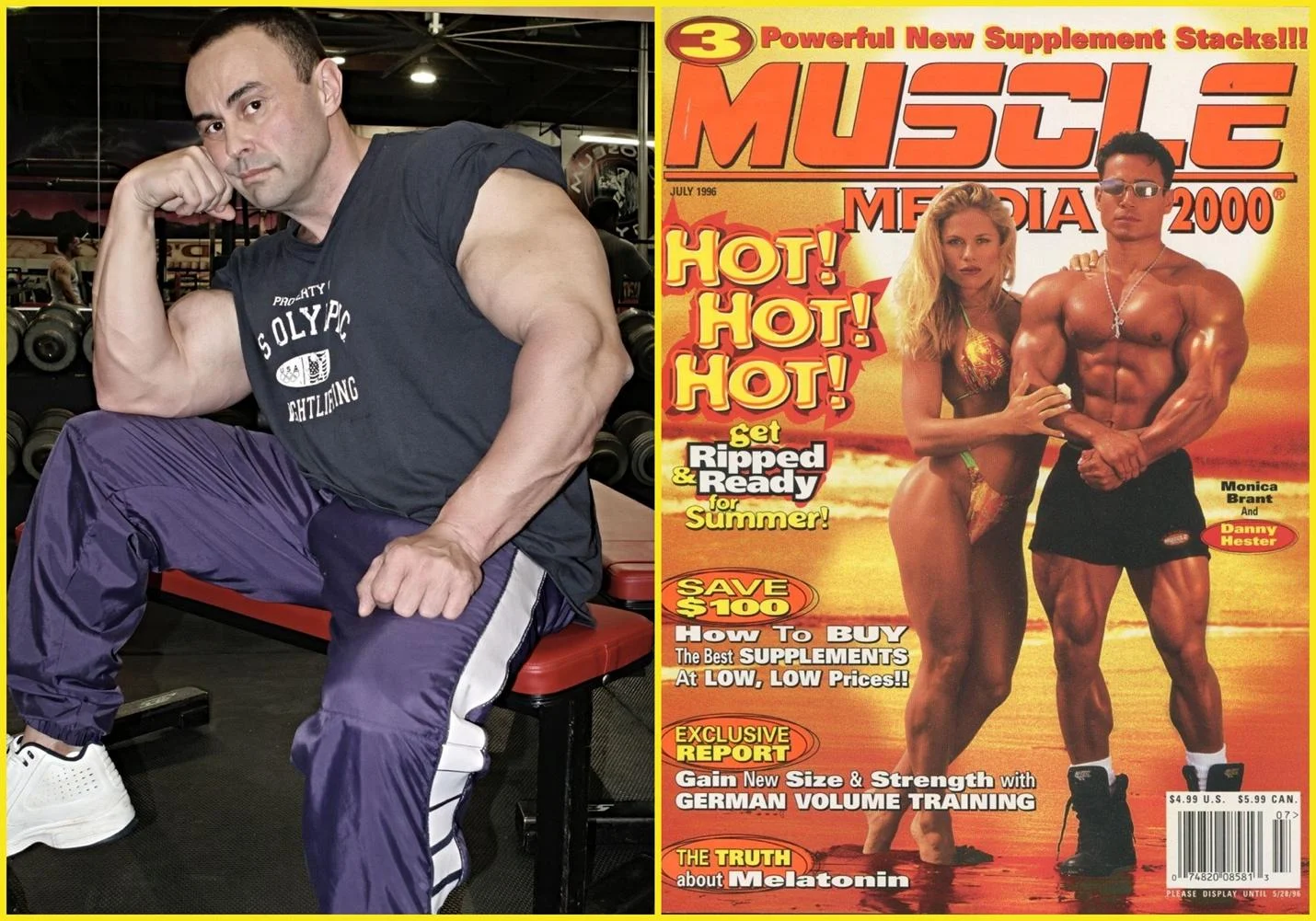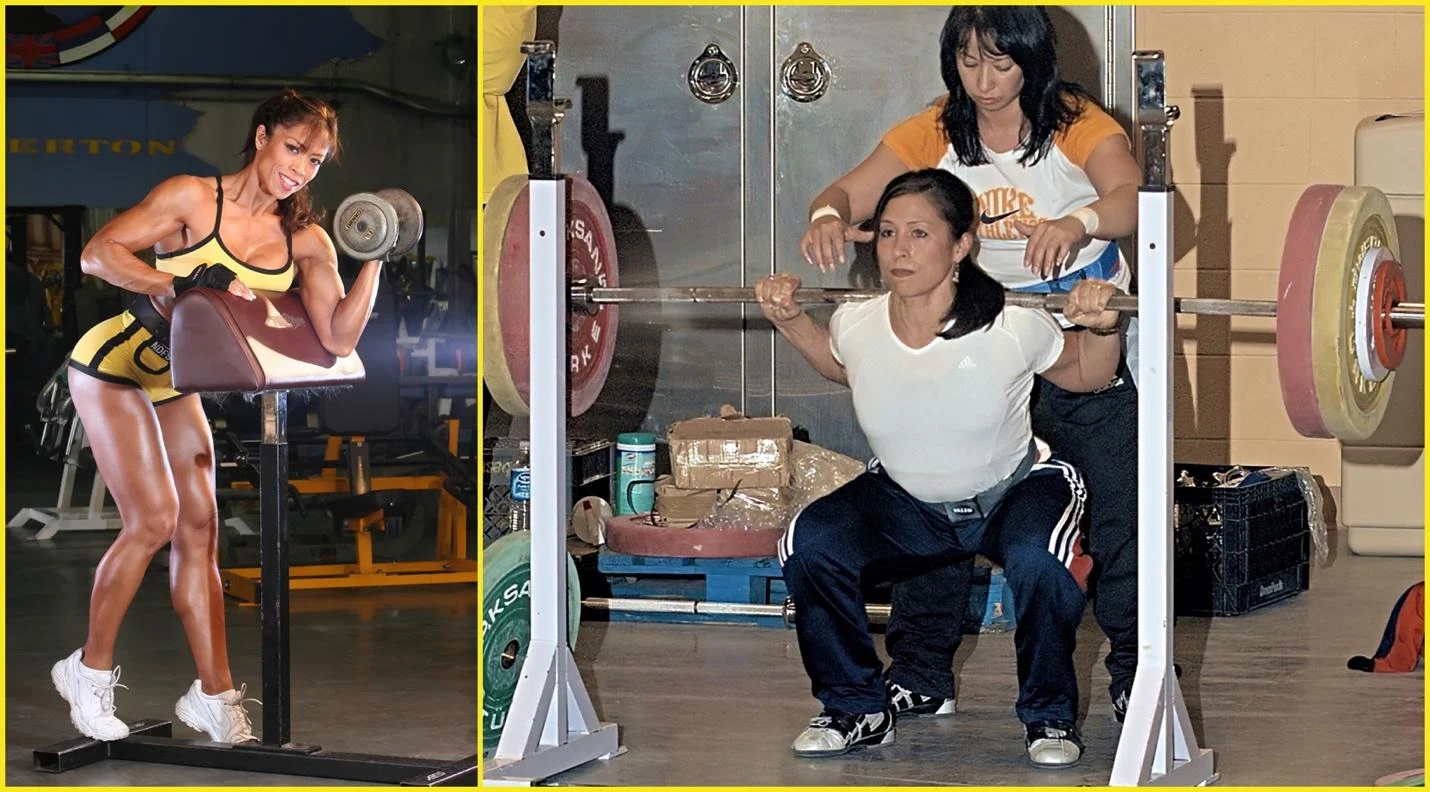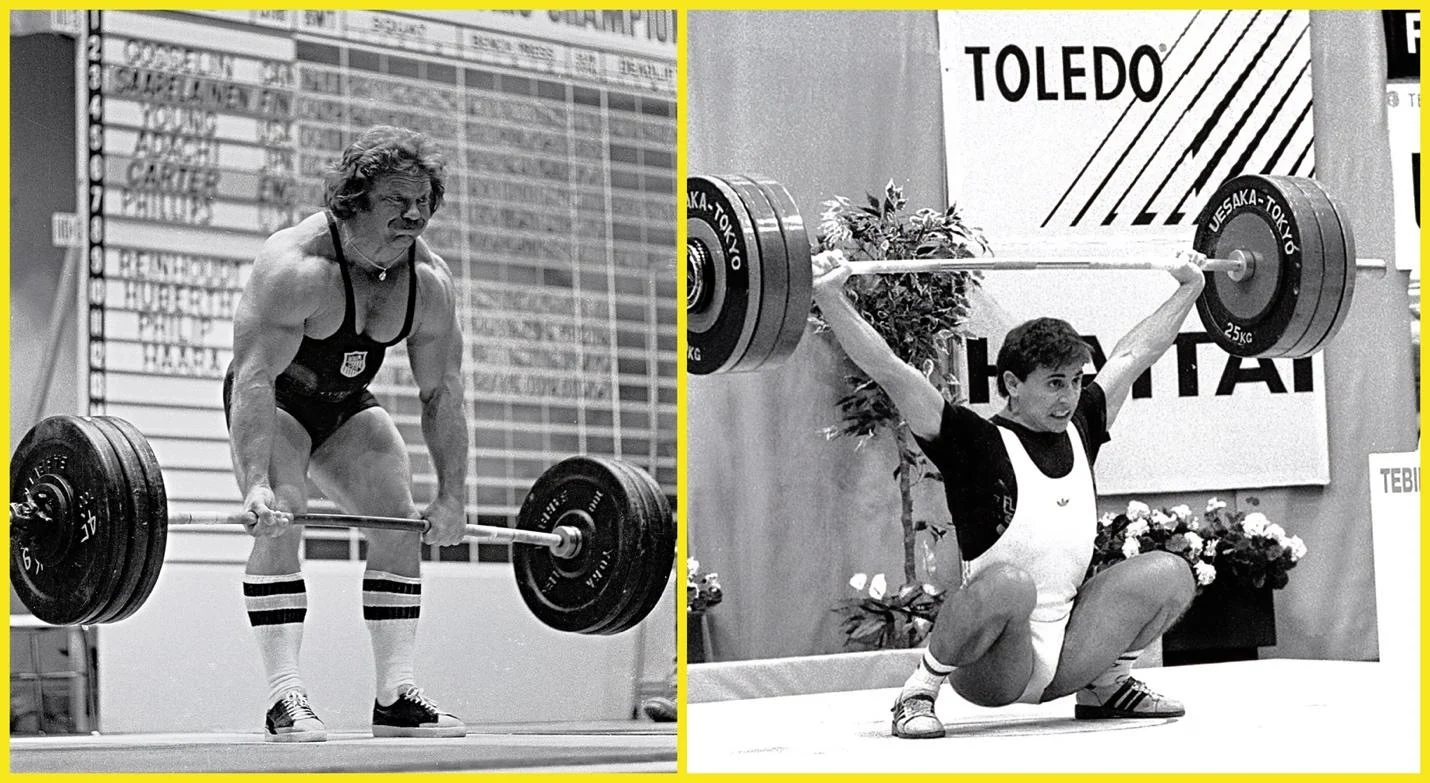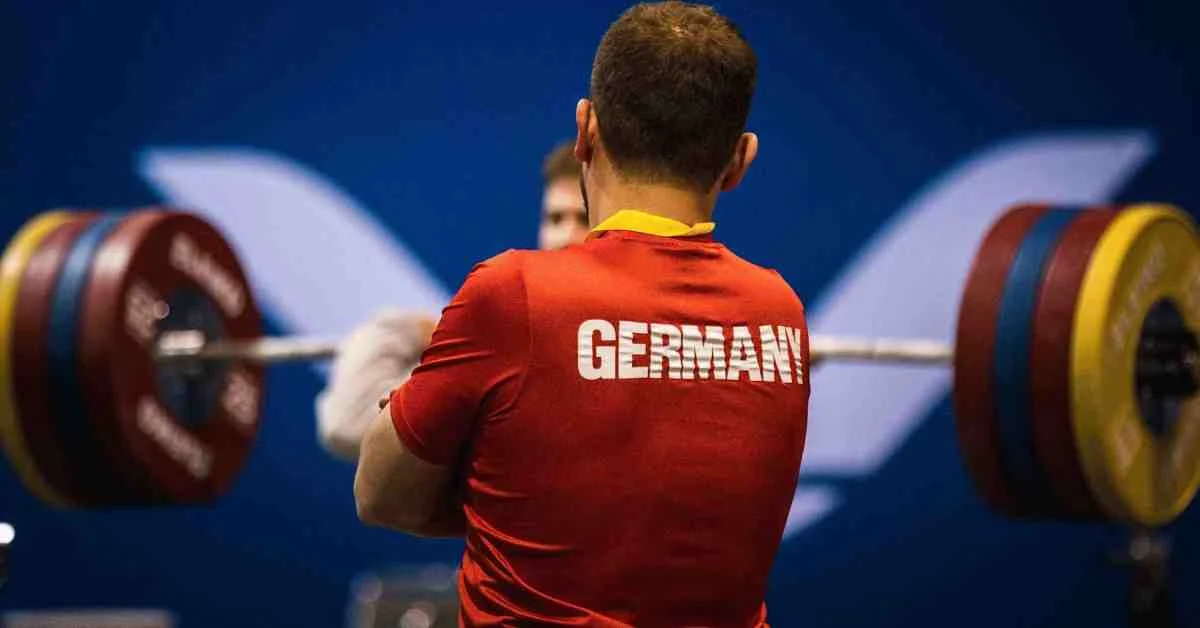Feature Image by Viviana Podhaiski, LiftingLife.com
The truth about Charles R. Poliquin’s revolutionary workout
Introduction
Legendary strength coach Charles R. Poliquin introduced German Volume Training to the Iron Game community in 1996. Since then, considerable misinformation has been written and spoken about it, particularly its value in improving athletic performance. I’m here to set the record straight.
In 1987, I was hired as a strength coach at the U.S. Air Force Academy in Colorado Springs. I spent every Saturday morning at the nearby Olympic Training Center Library. These were the days before the Internet, and this exceptional library offered rare books and sports journals from around the world that you couldn’t find anywhere else.
I found many articles and coaching presentations by Poliquin in this library—knowledge bombs that motivated me to attend a seminar he gave in San Diego. There, I was able to discuss with him how to implement his methods with my athletes. The improvements in strength and other aspects of athletic fitness I saw using Poliquin’s methods with my athletes were impressive.
Over the next few years, I spent much of my meager disposable income on long-distance calls to Canada to gather insights about Poliquin’s training methods. One workout system that intrigued me was the one he called German Volume Training, as Poliquin claimed that it was not uncommon to hear about men who used it gaining five pounds of muscle in three weeks. I wanted to test this claim, and I had the perfect candidate, Craig Shepherd.
Shepherd, an elite collegiate hockey player from the United States, asked for my help to “bulk up.” He was 6-1 and about 203 pounds, and believed his best chance of stepping up to the NHL was by becoming an “enforcer” (which is a title that Indiana Fever fans have recently bestowed upon the sassy and fierce Sophie Cunningham). Besides taking boxing lessons (after all, this is hockey), Shepherd wanted to pack on substantial muscle mass to create a more intimidating presence on the ice. Poliquin said GVT would be the perfect workout for Shepherd.
In less than three months, Shepherd gained over 40 pounds of body weight, much of it muscle. He also became ridiculously strong for a hockey player, bench pressing 405 pounds and power cleaning 285. Although he transformed into what could best be described as a clone of the Undertaker from the WWE, the NHL teams did not need enforcers at that time. There’s more.
After abandoning his job search as an enforcer, Shepherd began trimming down to normal hockey size and was soon, somehow, drafted by Dynamo Moscow of the former Soviet Elite League. While in Russia, he fell in love with and married Natalia Mishkutionok, an Olympic champion in pairs figure skating. Inspired by the movie The Cutting Edge, Shepherd swapped his hockey skates for toe picks and started competing professionally in pairs figure skating— but that’s another story.
GVT provides overload with volume, which can be measured by the number of reps performed. The beginner-level GVT workout involves performing 10 sets of 10 reps, says Kim Goss Share on XBriefly, GVT provides overload with volume, which can be measured by the number of reps performed. The beginner-level GVT workout involves performing 10 sets of 10 reps with the same weight for an exercise, resting 60 seconds between sets (90-120 seconds if performed with supersets). Only 1-2 exercises are performed in a workout using this protocol, and the exercises should involve a large amount of muscle mass, such as squats or bench presses. However, as I will explain later, there is an advanced variation of GVT that is more suitable for developing maximal strength and power. But first, let’s look at some of the specific benefits of GVT for athletes.

Image 1. Charles R. Poliquin introduced German Volume Training to the Iron Game in the July 1996 issue of Muscle Media 2000. (Left photo by Miloš Šarčev)
Muscle Bound or Bound for Muscle?
Certainly, most sports coaches working with athletes who have “the need for speed” see little value in the training methods of professional bodybuilders. I’ve heard one coach use the analogy that he wants to build thoroughbreds, not draft horses. I understand this perspective, and I would add that the finalists in the Mr. Olympia bodybuilding competition probably would not do well in the 40-yard dash. That said, let’s look at three reasons why athletes could benefit from occasionally incorporating a muscle-building workout like GVT.
1. GVT Can Help Athletes Lose Body Fat
Because GVT is a superior method of increasing muscle mass, it can raise metabolism, which is the rate at which the body consumes energy. It follows that an increase in metabolism can help an athlete decrease their bodyfat, especially for women.
“In my 34 years of experience as a strength coach, for every kilogram or pound of lean tissue my female clients gain, they generally lose an equal amount of body fat,” said Poliquin. “Let’s say a woman weighs 60 kilograms (132 pounds), has 20 percent body fat, and therefore 12 kilograms (26 pounds) of fat. If she gains 4 kilograms (8.8 pounds) of muscle in 10 weeks, she will probably lose 4 kilograms of fat and lower her body fat to 13 percent.”
Poliquin says another advantage of GVT is that focusing on multi-joint exercises may be more appealing for women. “Many beginning-level bodybuilding programs contain a lot of isolation-type exercises, such as triceps pressdowns and barbell biceps curls. These exercises are fine, but many beginning-level women trainees do not like the “pump” associated with such exercises. Multi-joint exercises such as squats and deadlifts are certainly hard but generally will not result in the same level of discomfort [from a pump] because the effort is spread among different muscles.”
Some coaches believe that to lose fat quickly, athletes should run long distances or spend extended periods on cardio machines. I know of a Division 1 college gymnastics coach who made his athletes wear heart rate monitors while riding stationary bikes to ensure they spent the optimal amount of time in the “fat-burning zone.” After each workout, the athletes uploaded their data to the coach’s computer. If an athlete didn’t stay in their zone long enough, she had to repeat the workout. Intense.
One issue with steady-state cardio is that it can compromise strength and power, causing fast-twitch muscle fibers to perform like slow-twitch fibers. Although many sports have an aesthetic component and their athletes turn to steady-state cardio to get and stay lean, these athletes must be careful not to lose their explosiveness. An extreme example is women’s figure skating, a sport that combines aesthetic elements with jumps, such as the triple axel, that demand immense power.
Steady-state aerobic training can also trigger an overproduction of the hormone cortisol. Poliquin called cortisol the “stress hormone,” and said it is associated with fat gain. He told me about a study showing that aerobic instructors who led the most classes had the highest body fat levels, which he believes were linked to increased cortisol levels. This prompted Poliquin to coin the term “The Chunky Aerobics Instructor Syndrome.”
Here’s what many coaches and athletes don’t realize: After an athlete loses fat using GVT, much of the extra body mass, including non-contractile substances, will quickly disappear if higher-rep resistance training isn’t performed regularly—but the fat that was lost during this training is still gone (more on this topic later).
Image 2. Aerobic training can help an athlete lose weight (and perhaps even boost their skills on the dance floor), but it can also negatively impact an athlete’s strength, speed, and power.
2. GVT Trains the Brain
In my initial conversations with Poliquin, he told me that GVT can help athletes from a motor learning perspective. Let me explain this idea with an analogy.
Figure skating has an aesthetic component, and to create a presentation that appeals to judges, these athletes often go on extreme diets a month or more before major competitions. The problem is that the technical aspects of skating are so precise that losing, say, three percent of their body weight can significantly impact a skater’s balance during jumps. While bodybuilders can get away with “bulking up and cutting down,” their competitions don’t involve jumping in the air and landing on a patch of ice while balanced on a thin steel blade. OK, let’s extend this analogy to other sports, but from a weight-gain perspective.
In my initial conversations with Poliquin, he told me that GVT can help athletes from a motor learning perspective, says Kim Goss Share on XLet’s consider a high school male freshman who joins the wrestling team. He’s 5-9 and weighs 125 pounds. Based on his height, he should probably be wrestling at 170 pounds by his senior year. If this athlete gains 15 pounds of muscle over the next three years, he will have less than a year to get accustomed to competing at that optimal bodyweight.
Instead, this athlete could use GVT to reach 170 pounds sooner, perhaps by the beginning of his sophomore year, giving him more time to get comfortable at this heavier body weight. Yes, much of the muscle this wrestler initially acquires through this workout will be slow-twitch, but it can be gradually replaced by the development of fast-twitch muscles through higher-intensity weight training methods. In effect, the showy bodybuilding muscles that will crown you “The Hero of the Beach” will be replaced by powerful muscles that will make you “The Hero of the Mat.”
Another example is a football lineman trying to bulk up. Often, these athletes become obsessed with adding bodyweight after their junior season, perhaps because they are pursuing a scholarship. They pick up the latest issue of Musclebulk Express magazine and start packing on bodyweight the old-fashioned way (adding muscle and fat) in preparation for their senior season. Like the wrestler, the athlete has only a short time to adjust to the heavier body weight, which may include a significant amount of fat, and their performance suffers.
3. GVT Boosts Testosterone Levels
Poliquin believed that combining high-volume exercises with relatively short rest periods would boost testosterone production. It’s true, as research has confirmed that resistance training can increase testosterone levels, especially when using exercises that engage a large amount of muscle mass (i.e., squats over calf raises).
Matthew G. Villanueva and his colleagues conducted a study published in 2012 on the hormonal effects of various weight training protocols on testosterone and cortisol production. They found that 60 seconds of rest between sets was more effective than 90 seconds in increasing testosterone levels, and that neither rest protocol significantly raised cortisol levels. They concluded that performing high-intensity strength training with shortened rest intervals “may lead to concomitant enhancements in muscle strength and size over a longer period of training.”
Before diving into the details of GVT program design, let’s give credit where it’s due and explore the history of GVT.

Image 3. GVT can help football linemen gain the body mass they need to become unstoppable forces or immovable objects. The workout can also help athletes in weight division sports achieve their optimal competitive bodyweight sooner, providing them with more time to get accustomed to competing at this bodyweight.
The Francis Factor
When I first asked Poliquin about the origins of GVT, he said Bev Francis helped popularize it. Francis is an Australian national champion shot putter who competed in the 1979 World Cup of Track and Field.
Francis’s training was influenced by Franz Stampfl. Stampfl was a pioneer in interval training who worked with Roger Bannister of 4-minute mile fame. During her “foundation” phase, Stampfl had Francis perform a type of interval training by supersetting 10 sets of 10 reps of the bench press with 10×10 of the squat. She rested for five minutes after each superset and repeated this sequence until she completed all 10 sets. Do the math—that’s 200 reps of two of the most challenging exercises in the weight room. Whew!
While her throwing accomplishments made Francis a household name in Australian Athletics, the muscle she packed on from her earlier training captured the attention of the general public. Francis appeared in the 1985 movie Pumping Iron II: The Women, where she presented an unparalleled level of muscle mass that “changed the game” in these competitions. Francis went on to place second in the 1990 and 1991 Ms. Olympia, considered the pinnacle of bodybuilding competitions.

Image 4. Bev Francis used 10×10 workouts in her training to help her achieve physical superiority. Francis also excelled in bodybuilding and was featured in the movie Pumping Iron II: The Women.
Poliquin believed the GVT workout originated in German-speaking countries in the mid-1970s and was called the “10 Sets Method.” He also said that this workout was a favorite of Rolf Feser, the National Coach of Weightlifting in Germany. Similarly, Canadian weightlifter Jacques Demers used GVT to help him quickly move up a bodyweight class where he could be more competitive. Demers won a silver medal at the Los Angeles Olympics and was coached by Pierre Roy, Poliquin’s mentor in weightlifting.
Another coach who should be recognized in this GVT history lesson is Vince “The Iron Guru” Gironda. Gironda was a bodybuilding legend who trained Larry Scott, the first Mr. Olympia, and his Hollywood clientele included Cher, Clint Eastwood, and Denzel Washington. He was also a prolific writer, and one of his most popular programs was the Gironda 8×8 System.
While the difference between the total work done by the two systems is significant—8×8 (64 reps) and 10×10 (100 reps)—it was the rest periods that radically changed the training stimulus. In Gironda’s system, the workout began with a 60-second rest between sets, gradually decreasing to 15 seconds.
Gironda’s approach was similar to a fat loss program promoted by Poliquin called German Body Comp, which uses 30-second rest intervals. Poliquin believed this protocol increased growth hormone production, which in turn helped reduce body fat. However, the extreme fatigue associated with such rest protocols reduces the workout intensity and thus its muscle-building and strength training effects.
With that background, let’s take a closer look at the components of GVT.

Image 5. The popularity of the German Volume Training program resulted in many books being written about it.
How to Program German Volume Training
Poliquin described his workouts using loading parameters. Loading parameters include exercises, number of exercises, repetitions, sets, tempo, rest intervals, frequency, duration, and progression. Here’s how these variables are broken down in GVT:
Exercises
Poliquin said the exercises for GVT should deliver the most “bang for your buck” by working a large amount of muscle mass. This means the exercises are mainly multi-joint, such as squats and overhead presses. Poliquin says that when you use these types of exercises, the smaller muscles will also receive growth stimulation. For example, performing chin-ups will also target the forearms and biceps.
I should mention that when Poliquin asked me to edit his (now classic) article on GVT for Muscle Media 2000 magazine in 1996, he told me he only added extra exercises for smaller muscle groups to help promote the program within the bodybuilding community.
Number of Exercises
One exercise is performed per body part. Due to the high number of sets per exercise (10), only 1-2 exercises are performed per workout with the 10×10 protocol. If more exercises are added, the best would be single-joint exercises, and the number of sets should be limited to no more than three.
Reps and Sets
Ten reps are performed for 10 sets with the same weight. Because you must strive to complete every rep of every set, the weight must be relatively light.
While percentage charts are convenient, many variables—such as muscle fiber type—can influence the number of reps that can be performed at a given percentage of the 1-repetition maximum. As such, Poliquin preferred to “let the repetitions determine the load.” However, as a general guideline, for your first workout, he recommends choosing a weight that is 60 percent of your one-repetition maximum, or what you could lift for a set of 20 reps.
Tempo:
For long-range lower-body (long-range) exercises, such as squats, a general guideline is to lower the bar in four seconds. For example, a squat may have a tempo prescription of 4011. You would squat down in four seconds, immediately return to the start without pausing, and pause for one second at the top. For upper-body (short-range) exercises, such as the bench press, generally a three-second lowering phase is recommended.
Rest Intervals:
Approximately 60 seconds of rest is taken between sets, although Poliquin recommends expanding this to 90 seconds for especially challenging exercises, such as squats. Including the time to perform the exercise, it could take 20-25 minutes to complete a single exercise. (Note: Poliquin recommended using a stopwatch with GVT, as it’s tempting to rest longer during the later sets due to fatigue.)
If organized as supersets, 90-120 seconds of rest should be prescribed, as considerably more fatigue is created with two exercises. The downside is that it is often impossible to perform supersets in commercial gyms, as it would monopolize two pieces of equipment for too long. Here are examples of both protocols:
Station Training
- Back Squat, 10×10, 4011, rest 90 seconds
- Bench Press, Barbell, 10×10, 3011, rest 60 seconds
Superset Training
A1. 45-Degree Incline Press, Dumbbells, 10×10, 3011, rest 90 seconds
A2. Seated Horizontal Row, Straight Bar, 10×10, 3011, rest 90 seconds
B1. Dumbbell Fly, 3×10, 3011, rest 60 seconds
B2. Bent-over Lateral Raise, Dumbbells, 3×10, 3011, rest 60 seconds
Frequency:
Because German Volume Training is highly demanding, recovery time is longer. Therefore, training each major muscle group once every four to five days is sufficient. One bodybuilding split Poliquin recommended for GVT was structured as follows:
Day 1: Chest and Back
Day 2: Legs and Abs
Day 3: Rest
Day 4: Arms and Shoulders
Day 5: Rest
Duration:
Poliquin believed that when your progress begins to plateau, it’s time to adjust one or more loading parameters. Depending on the athlete’s strength level, Poliquin recommends changing workouts about every 2-3 weeks, particularly the reps and sets. Let’s take a look at the approach I used for the Shepherd who wanted to bulk up and get stronger and more powerful.
Poliquin told me to have Shepherd alternate between workouts that emphasized building muscle mass (GVT) and high-intensity workouts that focused on developing maximal strength and power. He referred to these workouts as accumulation (high volume) and intensification (high intensity). Image 6 shows an example of a program alternating GVT protocols with those of relative strength.
| Weeks | 1-2 | 3-4 | 5-6 | 7-8 |
|---|---|---|---|---|
| Reps | GVT | 3-5 | GVT | 2-3 |
| Sets | GVT | 4-5 | GVT | 5-6 |
| Rest | GVT | 3-4 min | GVT | 4-5 min |
| Intensity | GVT | 85-90% | GVT | 90-95% |
Image 6. A workout alternating between GVT and relative strength training protocols.
Progression:
Only during the last set can the weight be so heavy that you may not be able to complete all the reps. If you can’t complete all the reps on that set, stay with that weight for the next workout. If you complete all 100 reps, increase the weight by four to five percent.

Image 7. The German Volume Training program emphasizes multi-joint movements, such as squats, rather than isolation exercises, like the one-arm preacher curl. (Left photo by Miloš Šarčev, right photo by Bruce Klemens)
Advanced GVT for Athletes
Before transitioning into bodybuilding, Francis competed in powerlifting and was dominant. She was the first woman to officially bench press 300 pounds, won six World Championships, and broke 40 world records.
Francis competed in the 165- and 181-pound weight classes. Her best lifts included a 500-pound squat, a 335-pound bench press, and a 501-pound deadlift—all achieved before the era of the special lifting “gear” permitted in many of today’s powerlifting federations that enables athletes to lift much heavier weights. However, her powerlifting training required a different approach to training intensity.
Francis told writer Ron Fernando that Francis still followed the 10-set format but would vary the reps throughout the week. “I would do the 10-set complex six days a week, but would alternate between 10s, 8s, 6s, 5s, 4s, and 3s. I would perform the 10x10s on Monday, 10x8s on Tuesday, 10x6s on Wednesday, 10x5s on Thursday, 10x4s on Friday, and finally the 10x3s on Saturday.”
These variations are particularly notable because Poliquin later created a modified GVT program using fewer reps, which he called Advanced GVT (AGVT). He said that elite athletes needed to decrease the reps to maintain the same intensity level, as they are more “neurologically efficient.”
Poliquin said neurological efficiency refers to a person’s ability to activate their higher-threshold (fast-twitch) muscle fibers effectively. If someone is neurologically inefficient, they respond better to lower-intensity loads (meaning more reps) because they can’t effectively recruit the higher-threshold muscle fibers to lift the weight.
In review, intensity is determined by the percentage of the weight relative to the one-repetition maximum. The GVT program prescribes sets of 10 reps, which translates to about 75 percent of the 1RM (but consider that GVT is performed for 10 sets, which is why Poliquin suggests a starting weight of 60 percent of your 1RM). For more advanced athletes, Poliquin recommended an AGVT program that involves sets of 6 reps, which equates to about 86 percent. The higher percentage would also lead to less increase in body mass—let me expand on this point.
Bodybuilding training produces sarcoplasmic hypertrophy, which increases glycogen storage and fluid volume, but does not enhance force production. As a result, muscles grow larger without significant increases in strength. In contrast, training at higher intensities promotes myofibrillar hypertrophy. Training at higher intensities produces myofibrillar hypertrophy, which focuses on increasing the strength of fast-twitch muscle fibers without significant development of non-contractile substances that increase bodyweight but do not enhance strength and power.
Before moving on, I must mention that in later years, some Poliquin-endorsed instructors recommended as few as three reps for AGVT, with incomplete sets on the last three to four sets. “It is what it is,” but I would argue that if maximal strength is the goal, Poliquin would have suggested other training systems, especially cluster training. Again, the purpose of GVT is to overload by volume, not intensity.

Image 8. Although gaining high levels of muscle mass can benefit powerlifters, the extra bodyweight might be detrimental in bodyweight division sports such as weightlifting. (Photos by Bruce Klemens)
GVT vs. Sports Science
A workout as popular as GVT does not go unnoticed by the scientific community. Case in point: “Effects of a Modified German Volume Training Program on Muscular Hypertrophy and Strength,” published in the November 2017 Journal of Strength and Conditioning Research.
Heading the study was Theban Amirthalingam from the Discipline of Exercise and Sport Science at the University of Sydney, Australia. The study compared a “modified” GVT program to one that uses five sets instead of 10 for the primary exercises. The study involved 19 adult subjects, ages 19-24. The GVT group had 3.5 +/- 1.0 years of training experience, and the modified group had 4.8 +/- 4.8 years of training experience.
First, I was perplexed that the authors didn’t reference Poliquin’s MM2K article or his earlier writings on the subject. If you’re going to critique a workout program in a peer-reviewed journal, shouldn’t you mention the source material? After all, why is a workout using 10 reps considered German?
Next, compared to the original GVT, these researchers altered the training frequency, training splits, exercise selection, starting intensity level, and set-by-set intensity. What the heck!
Because the GVT program they prescribed bore little resemblance to Poliquin’s, a more appropriate title might be “Effects of the Genovia Volume Training Program on Muscular Hypertrophy and Strength.” (FYI: Genovia is the fictional country in the Disney classic The Princess Diaries, featuring future Oscar winner Anne Hathaway.)
What is particularly disturbing about this study is that it is often mentioned in articles, books, and social media. For example, one of the books on Amazon is titled German Volume Training by Akshay Chopa, published by a company called (for whatever reason) “We R Stupid.” The author states that a study published in 2016 [actually, 2017] found that doing half the number of sets in GVT appears more effective. Again, damage done.
Another Australian study, published in 2009, was titled “The Deleterious Acute Effects of High Volume-Load German Volume Workout Upon Upper Body Power Output.” The study aimed to determine whether upper body power would be affected immediately after performing an upper body GVT program (again, that word “German”). Power was measured by tossing an 88-pound medicine ball in a bench press motion. The authors noted that sometimes they had to reduce the amount of weight used to complete subsequent sets of 10 reps, thus deviating from Poliquin’s protocol.
Using a tri-set format, the subjects performed a 10×10 protocol of the bench press, incline dumbbell row, and abdominal curl-up. Ninety seconds after exhausting themselves with this 300-rep workout, the subjects performed a chest pass with the medicine ball. Yes, 90 seconds. The result was an average 23 percent decrease in performance—shocking, indeed. After an additional five minutes of rest, the decrease was 18.3 percent. Who would have guessed?
The author’s recommendations included avoiding GVT before doing power work, which I (and Captain Obvious) would agree with. Moreover, Poliquin never claimed that the beginner-level GVT workout was the best workout to improve strength or power, instead promoting other workout systems for this goal, particularly cluster training.
I want to emphasize that this discussion is based on my interpretation of German Volume Training. I was Poliquin’s primary editor for nearly 20 years, so I’m confident that is how he prescribed this workout. I realize that many books have been written about GVT, as shown in Image 5. However, I had no involvement with these publications, and, to the best of my knowledge, neither did Poliquin.
Charles R. Poliquin’s favorite motto was “Success Leaves Clues,” and the GVT program has nearly fifty years of positive testimonials. If athletes need to alter their body composition significantly and in a hurry, the German Volume Training program may be just the workout they need.
References
Poliquin, Charles. “Theory and Methodology of Strength Training: Part 1.” Sports Coach. September 1989, pp. 25-27.
Poliquin, Charles. “German Volume Training: A New Look at an Old Way to Get Big and Strong.” Muscle Media 2000. July 1996, pp. 128-133.
Villanueva MG, Villanueva MG, Lane CJ, Schroeder ET. “Influence of Rest Interval Length on Acute Testosterone and Cortisol Responses to Volume-Load-Equated Total Body Hypertrophic and Strength Protocols.” Journal of Strength and Conditioning Research. October 2012; 26(10): pp. 2755-64.
Fernando, Ron. “The Greatest of All Time: The Bev Francis Story.” Powerlifting USA
https://www.bevfrancis.com/wp-content/uploads/2016/01/bevpowerlifting.pdf
Amirthalingam T, Mavros Y, Wilson GC, Clarke JL, Mitchell L, Hackett DA. “Effects of a Modified German Volume Training Program on Muscular Hypertrophy and Strength.” Journal of Strength and Conditioning Research. November 2017; 31(11): pp. 3109-3119.
Daniel Baker and Robert U. Newton. “The Deleterious Acute Effects of High Volume-Load German Volume Workout Upon Upper Body Power Output.” Journal of Australian Strength and Conditioning. June 2009; 17(2): pp. 11-17.





